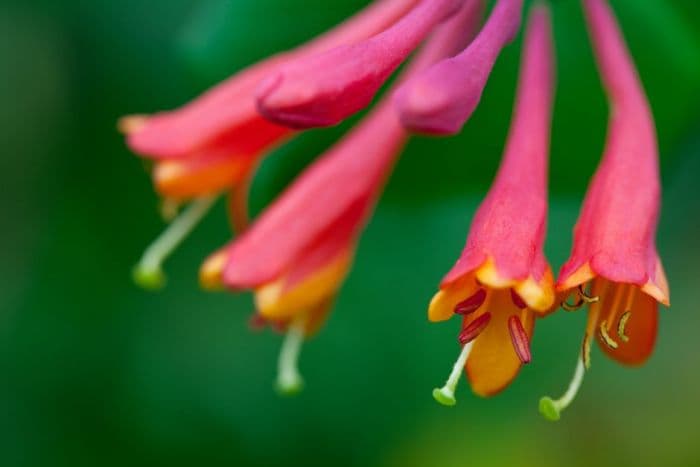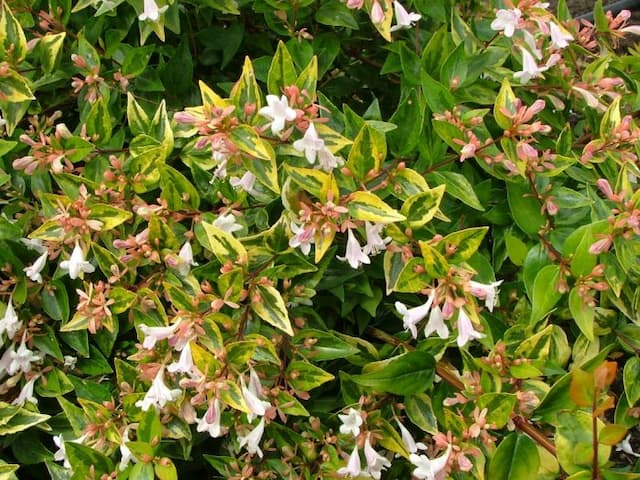Dropmore Scarlet Honeysuckle Lonicera × brownii 'Dropmore Scarlet'

ABOUT
The Dropmore Scarlet Honeysuckle is a vibrant and visually striking plant. This cultivar is particularly noted for its profusion of vibrant, trumpet-shaped flowers which exhibit a fiery scarlet hue that can add a pop of color to any garden. The blossoms are accented with touches of orange on the inside, creating a two-tone effect that is quite captivating. These flowers tend to attract a variety of pollinators, including hummingbirds and butterflies, due to their bold color and sweet nectar. The foliage of the Dropmore Scarlet Honeysuckle comprises oval leaves that grow in pairs along the stems. The leaves are a deep green color, providing a lush backdrop for the bright flowers. In some cases, the leaves may add to the ornamental value with a slight bluish or glaucous tinge, although the green coloration is the most prominent. This variety of honeysuckle is a climbing plant and is known to have a vigorous growth habit. It can grow up around structures such as trellises, arbors, fences, or even other plants. The stems of the honeysuckle are flexible and twining, enabling them to wrap around supports for stability as they grow. The blooms of the Dropmore Scarlet Honeysuckle generally appear in late spring and often continue into the late summer months, providing a long-lasting display of color in the garden. When the flowers are spent, they may be followed by small, red berries that hold some ornamental value but are typically not the main attraction of this plant. In summary, the Dropmore Scarlet Honeysuckle is celebrated for its scorching scarlet flowers and appealing, long blooming season, set against a canvas of rich green foliage, making it a favorite among gardeners looking to add vertical interest and a splash of color to their outdoor spaces.
About this plant
 Names
NamesFamily
Caprifoliaceae
Synonyms
Dropmore Scarlet Honeysuckle, Scarlet Trumpet Honeysuckle
Common names
Lonicera × brownii 'Dropmore Scarlet'.
 Toxicity
ToxicityTo humans
Honeysuckle is the common name for the plant Lonicera × brownii 'Dropmore Scarlet'. Some species of honeysuckle are considered to have toxic properties, especially the berries, which can cause symptoms if ingested in large quantities. Ingesting honeysuckle can lead to gastrointestinal upset, such as nausea, vomiting, and diarrhea. While not generally deadly to humans, it is still advisable to avoid consuming any parts of the plant, particularly the berries.
To pets
Honeysuckle, specifically Lonicera × brownii 'Dropmore Scarlet', can be toxic to pets if ingested. The level of toxicity and the specific symptoms can vary depending on the quantity ingested and the sensitivity of the individual pet. Symptoms of honeysuckle poisoning in pets may mirror those in humans, including gastrointestinal upset, such as vomiting and diarrhea. It is important to discourage pets from chewing on or ingesting any part of the plant to prevent potential toxicity.
 Characteristics
CharacteristicsLife cycle
Perennials
Foliage type
Deciduous
Color of leaves
Green
Flower color
Scarlet
Height
6-8 feet (1.8-2.4 meters)
Spread
5-6 feet (1.5-1.8 meters)
Plant type
Climber
Hardiness zones
4
Native area
Cultivar
Benefits
 General Benefits
General Benefits- Attractive Flowers: Dropmore Scarlet Honeysuckle produces vibrant red-orange tubular flowers which add a splash of color to the garden.
- Wildlife Attraction: The flowers are a nectar source for hummingbirds and butterflies, making it an excellent choice for attracting wildlife.
- Drought Tolerance: Once established, it has a good tolerance for drought conditions, making it suitable for areas with low rainfall.
- Fast-Growing: This honeysuckle variety is known to grow rapidly, which can provide quick coverage for trellises, arbors, and fences.
- Fragrance: The flowers emit a pleasant fragrance that can add an aromatic experience to the surrounding area.
- Easy to Propagate: Dropmore Scarlet is relatively easy to propagate from cuttings, allowing gardeners to expand their plantings without additional cost.
- Long Blooming Period: The honeysuckle has a long flowering period, typically from late spring through summer, providing a lengthy display of blooms.
- Privacy Screening: Its dense foliage and fast growth make it an effective plant for creating privacy screens in the landscape.
- Low Maintenance: Requiring minimal care once established, it is a good choice for gardeners looking for low-maintenance plants.
- Versatility: It can be used in a variety of landscape applications, including as a ground cover, in containers, or as part of a mixed border.
 Medical Properties
Medical PropertiesThis plant is not used for medical purposes.
 Air-purifying Qualities
Air-purifying QualitiesThis plant is not specifically known for air purifying qualities.
 Other Uses
Other Uses- Lonicera × brownii 'Dropmore Scarlet', also known as Dropmore Scarlet Honeysuckle, can be trained to climb over trellises or pergolas to provide aesthetic garden architecture.
- This honeysuckle variety can be positioned near seating areas to enjoy its sweet fragrance during the blooming season.
- Dropmore Scarlet Honeysuckle can be used as a natural screen or living fence when planted in rows, helping to provide privacy in a garden or yard.
- Gardeners might use this plant to attract hummingbirds and beneficial pollinators, such as bees and butterflies, thus promoting pollination in the garden.
- The plant's dense foliage can be utilized to create shaded microclimates beneath its spread, offering a cool area for other shade-loving plants or a respite from the sun.
- Its long vines can be woven into natural art installations or decorative shapes that add a whimsical touch to garden landscapes.
- Photographers and artists may use Dropmore Scarlet Honeysuckle as a vibrant backdrop or a focal point for outdoor portraits and nature photography.
- The berries can be used for dyeing fabric or crafting natural inks, although they should be handled with care as they are not edible.
- Employing Dropmore Scarlet Honeysuckle in educational settings, such as school gardens, to teach students about plant growth habits, lifecycle, and the importance of native pollinators.
- Incorporating this honeysuckle into a garden-themed sensory space can engage the senses with its textured vines, colorful blossoms, and aromatic scent.
Interesting Facts
 Feng Shui
Feng ShuiThe Dropmore Scarlet Honeysuckle is not used in Feng Shui practice.
 Zodiac Sign Compitability
Zodiac Sign CompitabilityThe Dropmore Scarlet Honeysuckle is not used in astrology practice.
 Plant Symbolism
Plant Symbolism- Love and Devotion: As a variety of honeysuckle, Dropmore Scarlet is often associated with strong bonds and affection, symbolizing the devotion between loved ones.
- Generosity: Honeysuckles, including Dropmore Scarlet, can grow abundantly and produce copious flowers, representing generosity and the giving nature of a person.
- Happiness: The sweet fragrance and vibrant color of Dropmore Scarlet's flowers are thought to bring joy to those who encounter them, symbolizing happiness and good cheer.
- Bonds of Friendship: The intertwining vines of the honeysuckle can represent the close-knit relationship and unbreakable ties between friends.
 Water
WaterThe Dropmore Scarlet Honeysuckle should be watered deeply once a week, providing it with approximately 1-1.5 gallons of water each time for established plants in the ground. During the hot summer months or in drier climatic conditions, the frequency may need to increase to twice a week. For potted plants, water when the top inch of soil feels dry, ensuring that the water drains freely out of the pot's bottom. Be cautious of overwatering as it can lead to root rot, especially in cooler months when the plant requires less moisture.
 Light
LightDropmore Scarlet Honeysuckle thrives best in full sun to partial shade. Ideally, it should receive at least 6 hours of sunlight daily. A spot that is exposed to morning sun with some afternoon shade or dappled light throughout the day is ideal to protect it from the intense heat of late afternoon during peak summer months.
 Temperature
TemperatureDropmore Scarlet Honeysuckle prefers a temperate range and can generally tolerate temperatures between 20°F to 90°F. The ideal growing conditions include day temperatures around 70°F to 85°F. However, it can survive occasional dips below freezing. It's important to protect the plant from extreme temperature fluctuations and prolonged exposure to temperatures at the lower or upper ends of its tolerance range.
 Pruning
PruningPrune the Dropmore Scarlet Honeysuckle in late winter or early spring before new growth begins. Pruning is essential to shape the plant, encourage bushier growth, and remove any dead or damaged stems. It's recommended to cut back about a third of the oldest stems to ground level to rejuvenate the plant. Regular pruning also enhances the plant's flowering potential and maintains its overall health.
 Cleaning
CleaningAs needed
 Soil
SoilDropmore Scarlet Honeysuckle thrives in well-draining soil enriched with organic matter, with a soil pH ranging from 6.0 to 8.0. A mixture of loam, peat, and sand or perlite can create the appropriate texture and fertility for optimal growth.
 Repotting
RepottingDropmore Scarlet Honeysuckle, as a robust climber, generally does not require frequent repotting and should only be repotted if the plant has outgrown its current container or the soil has become depleted.
 Humidity & Misting
Humidity & MistingDropmore Scarlet Honeysuckle tolerates average garden humidity levels well; it does not require any special humidity conditions for healthy growth.
 Suitable locations
Suitable locationsIndoor
Place in bright, indirect light and ensure good air circulation.
Outdoor
Plant in sun or part-shade and prune to shape and size.
Hardiness zone
4-9 USDA
 Life cycle
Life cycleThe Dropmore Scarlet Honeysuckle begins its life cycle when seeds germinate in spring after experiencing a period of cold stratification which breaks their dormancy. It then enters a vegetative growth stage, rapidly developing a robust root system and vining stems that seek out support structures to climb or sprawl over. Throughout late spring to summer, the honeysuckle enters its flowering phase where numerous trumpet-shaped, scarlet to orange flowers bloom, attracting pollinators such as bees, butterflies, and hummingbirds. After pollination, these flowers develop into small, inedible red or black berries by late summer or fall, which are then dispersed by birds, completing the reproductive cycle. During autumn, as temperatures drop, the plant begins a period of dormancy, shedding leaves and slowing growth in preparation for winter's cold. With the return of favorable conditions in the next spring, the honeysuckle resumes growth, repeating the yearly cycle.
 Propogation
PropogationPropogation time
Early Spring
The Dropmore Scarlet Honeysuckle (Lonicera × brownii 'Dropmore Scarlet') is typically propagated by softwood cuttings taken in late spring or early summer. This method involves selecting a healthy, new growth stem that is not flowering. Cut a piece of the stem about 4-6 inches (10-15 cm) long, making sure that there are at least two sets of leaves. Remove the lower leaves to expose a node and dip the cut end into a rooting hormone to encourage root development. Then, plant the cutting in a pot filled with a mixture of peat and perlite, ensuring that at least one node is buried where roots can form. Keep the soil consistently moist and cover the pot with a plastic bag to keep the humidity high. In several weeks, once roots have formed and new growth appears, the cuttings can be transplanted to a more permanent location.

![Abelia [Sunshine Daydream]](/_next/image?url=https%3A%2F%2Fplants-admin.emdemapps.com%2Fimages%2Fplants%2F%2Fimages%2F604b61a1e9cdd.png&w=640&q=75)







